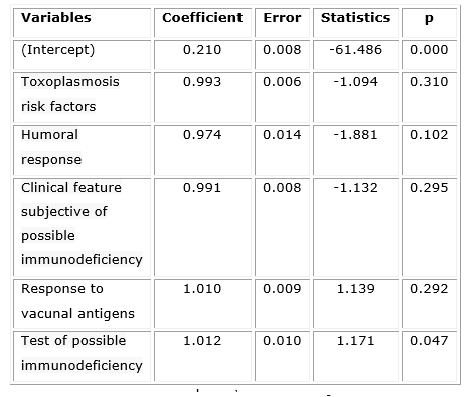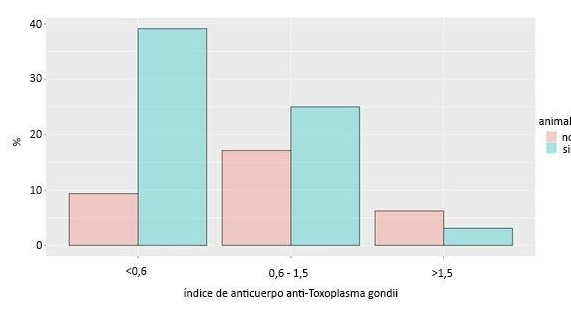Short comunication
IgG anti-Toxoplasma gondii antibody index as a measure of the naturally-acquired immune intrathecal response in a neuroepidemiological study
Indice de anticuerpos IgG anti-Toxoplasma gondii como medida de la respuesta inmune intratecal adquirida naturalmente según un estudio neuroepidemiológico
Mileydis Cruz Quevedo1
*
William Castillo González2
Alberto Juan Dorta Contreras3
1Universidad de Ciencias Médicas de La Habana, Instituto de Ciencias Básicas y Preclínicas “Victorias de Girón”. La Habana, Cuba.
2Universidad de Ciencias Médicas de La Habana, Facultad de Ciencias Médicas “Miguel Enríquez”. Cuba.
3Facultad de Ciencias Médicas “Miguel Enríquez”, Laboratorio Central de Líquido Cefalorraquídeo (LABCEL). La Habana, Cuba.
ABSTRACT
Introduction:
The presence of IgG anti-Toxoplasma gondii has been used as an indicator to measure the naturally-acquired immune intrathecal response due to the polyclonal and polyspecific intrathecal response developed in neuroinflammation processes. The absence of anti-Toxoplasma gondii antibodies in a subject who had been exposed to the parasite could be seeded as immunocompromised. The aim of the study is determine cases of autoimmunity and immunodeficiency.
Objective:
Demonstrate whether the IgG anti-Toxoplasma gondii antibody index can be used as an indicator of a population immune status seen through patients with neuroinflammatory processes.
Methods:
Cerebrospinal fluid (CSF) and serum samples were taken from 64 pediatric patients with intrathecal synthesis of antibodies and IgG anti-Toxoplasma gondii antibody indexes (AI) were determined.
Results:
The sample was divided in three intervals according to Hansotto Reiber investigations (≤0.6; 0.6-1.5; ≥1.5) and a mean interval ±1SD between 0.23 and 1.12. The groups were quite similar regarding to clinic and demographic characteristics; there were statics differences on anti-Toxoplasma gondii AI (p<0.01) and the presence of domestic animals (p=0.04). In the group with AI≥1.5, the 83.3% had positive the Measles-Rubella-Zoster reaction, indicative of active autoimmune disease. On the group with AI≤0.6 were analyzed six different variables trying to find possible cases with immunodeficiencies: risk factors to contract toxoplasmosis; subjective clinical of immunocompromise; a test to detect immunodeficiencies; response against vacunal antigens and humoral response determined by IgG levels in serum. The immunodeficiencies test was the variable with higher statistical significance (p= 0.047).
Conclusions:
The conclusion was that is possible to find subjects with autoimmune disorder and other ones with immunocompromise through the IgG anti-Toxoplasma gondii index by the developed investigation strategy.
Key words: Toxoplasma gondii; neuroimmunology; antibody index; immunodeficiency; autoimmunity
RESUMEN
Introducción:
La presencia de IgG anti-Toxoplasma gondii se ha utilizado como indicador para medir la respuesta inmune intratecal adquirida naturalmente, debido a la respuesta intratecal poliespecífica y policlonal que se produce en los procesos neuroinflamatorios. La ausencia de anticuerpos anti-Toxoplasma gondii en un sujeto que ha estado expuesto al parásito se puede ver como un caso de inmunocompromiso.
Objetivo:
Determinar casos de autoinmunidad e inmunodeficiencia.
Métodos:
Se tomaron muestras de líquido cefalorraquídeo (LCR) y suero de 64 pacientes pediátricos con síntesis intratecal de anticuerpos y se determinaron los índices de anticuerpos (IA) IgG anti-Toxoplasma gondii.
Resultados:
La muestra se dividió en tres intervalos según las investigaciones de Hansotto Reiber (·0,6; 0,6-1,5; ·1,5) y un intervalo medio ±1DE entre 0,23 y 1,12. Los grupos eran bastante similares en cuanto a sus características clínicas y demográficas, pero mostraban diferencias estadísticas en sus índices de anticuerpos anti-Toxoplasma gondii (p< 0,01) y la presencia de animales domésticos (p= 0,04). En el grupo con IA·1,5, el 83,3% tuvo una reacción positiva al sarampión-rubéola-zóster, lo que indica la presencia de enfermedad autoinmune activa. En el grupo con IA·0,6 se analizaron seis variables diferentes, tratando de encontrar posibles casos de inmunodeficiencia: factores de riesgo de contraer toxoplasmosis, historia clínica subjetiva de inmunocompromiso, una prueba para detectar inmunodeficiencias, respuesta ante antígenos vacunales y respuesta humoral determinada por niveles de IgG en suero. La prueba de inmunodeficiencias fue la variable que mostró la mayor significación estadística (p= 0,047).
Conclusiones:
Se concluye que es posible encontrar sujetos con trastornos autoinmunes y otros con inmunocompromiso a partir del índice de IgG anti- Toxoplasma gondii siguiendo la estrategia de investigación elaborada.
Palabras clave: Toxoplasma gondii, neuroinmunología; índice de anticuerpos; inmunodeficiencia; autoinmunidad
INTRODUCTION
The presence of IgG anti-Toxoplasma gondii has been used as an indicator to measure the naturally-acquired immune intrathecal response in a time-space population limited from the epidemiological point of view. This is possible because of the polyclonal and polyspecific intrathecal response developed in neuroinflammation processes. The absence of anti-Toxoplasma gondii antibodies in a subject who had been exposed to Toxoplasma gondii could be seeded as immunecompromised. The aim of the study is determine cases of autoimmunity and immunodeficiency.
METHODS
An applied descriptive study was performed in 64 pediatric patients from Havana City between 2015 and 2018. CSF and serum samples were taken for the detection of IgG anti-Toxoplasma gondii, rubella, parotiditis y measles antibodies by ELISA; a reibergram and specific antibody index were performed. Important patient data was obtained by questionnaire and patient clinical history.
RESULTS
All patients from the study had intrathecal synthesis as it is showed in the reibergram (Fig. 1)
The sample was divided in three intervals according to Hansotto Reiber investigations (≤0,6; 0,6-1.5; ≥1,5).
1).
The groups were quite similar regarding to clinic and demographic characteristics. However, there were static differences on anti-Toxoplasma gondii AI (p<0.01) and the presence of domestic animals (p= 0.04) (table 1 and figure 2). A mean interval was calculated ±1DS obtaining a range between 0.23 and 1.124; it is assumed that the patients below 0.23 could be classified as possible immunodeficients (n= 14).
Table 1. Distribution of patients according to selected variables

Source: Medical history. Test X2
In the group with AI≥1.5, the 83.3% were passive smokers and the 66.7% has the previous diagnosis of an autoimmune disease. The 83.3% had positive the Measles-Rubella-Zoster reaction.
On the group with AI≤0.23, the 64.3% had risk factors to contract toxoplasmosis; the 80.6% had subjective clinic of immunocompromise and 54.8% was positive in a test to detect immunodeficiencies. According to response against vacunal antigens, the AI anti-rubella and measles media were 0.1 and 0.2, respectively; the 90.3% had seroprotection against parotiditis and Measles and 93.5% against rubella. Regarding to humoral response, the 74.2% of patients had low IgG levels. The variable with higher statistical significance was the immunodeficiencies test (p=0.047) (table 2).
Table 2. Lineal regression model from variables studied in patients with suspicion of immunodeficiencies in relation with anti-Toxoplasma gondii antibody index

* Box and Cox transformation.
DISCUSSION
This study is supported in two main principles of the Neuroimmunology: In neuroinflammatory processes is produced a policlonal and polyspecific intrathecal response and every infectious or autoimmune agent that affects the central nervous system has an evident repercussion in CSF, direct or indirectly. The obtained results were remarkable, never before registered.
The analysis of the figure 2 shows controversial results because the higher prevalence of children with animals was in the group with AI≤ 0.6. Then, it is assumed that the investigator is in front of two groups with inadequate immunological responses.
The toxoplasmosis has been described as risk factor for autoimmune diseases. The six patients with AI≥1.5 had risk factors associated to autoimmunity, three of them were previously diagnosed with psoriasis, lupus erythematous systemic and vasculitis, and the MRZ reaction, powerful tool to establish a diagnose of multiple sclerosis and other autoimmune diseases, was positive in the 66,6% of the evaluated patients.2 This information proof these patients have real predictive factors of autoimmunity.
Los infants con IA≤0.23 had important risk factors widely described in previous studies for Toxoplasma gondii infection, such as: poverty associated conditions (51.6% ),
3)
low mother educational level,4 consumption of untreated water (57%)
5)
and the tenancy of cats and domestic animals (64.3%).3 Special attention should be focused in that the 51.7% of this children lived in areas with higher prevalence of Felis catus infected by Toxoplasma gondii.
6)
The obtained results proof that these patients could be in contact with the antigen and they should have higher titers of anti-Toxoplasma gondii antibodies.
The patient’s clinical history supported subjectively the presence of immunodeficiencies with repeated infections been causes of hospitalizations, often described in patients with immunodeficiency and diagnose of tumor diseases, which are the result of the escaping stage in the immunesurveillance against tumors.
7,8)
A proper way to evaluate the individual immunity is detecting protector levels of a vacunal antigen. The results show an inadequate response against it, what is common in immunodeficient ones or could be expression of a vaccination failure.9
Low levels of IgG in serum force a physician to transiently diagnose the patient as with a humoral immunodeficiency. The investigator recommends that it is necessary to perform subsequent immunological exams in order to make a proper diagnose.
Analyzing the results from the immunodeficiency test and the global prevalence of immunodeficiencies (1:10000), and taking into account that this variable had a p value of 0.047 in this study, it could interesting to determine why it is so high the incidence of possible immunodeficiency among those patients, a wrong diagnose or this is an effective method to identify immunodeficients who have not been properly diagnosed.10
CONCLUSIONS
It is possible to find subjects with autoimmune disorder and other ones with immunocompromise through the IgG anti-Toxoplasma gondii antibody index by the developed investigation strategy.
REFERENCES
1. Hansotto R. Knowledge-base for interpretation of Cerebrospinal fluid data patterns-Essentials in Neurology and Psychiatry. Arq Neuro-Psiquiatr. 2016 [acceso 13/01/2019];74(6):501-12. Disponible en: https://www.ncbi.nlm.nih.gov/pubmed/27332077
[ Links ]
2. Hottenrott T, Dersch R, Berger B, Endres D, Huzly D, Thiel J, et al. The MRZ reaction helps to distinguish rheumatologic disorders with central nervous involvement from multiple sclerosis. BMC Neurology. 2018 [acceso 13/01/2019];18(1):14. Disponible en: https://doi.org/10.1186/s12883-018-1018-3
[ Links ]
3. Carellos EVM, de Andrade GMQ, Vasconcelos-Santos DV, Januário JN, Romanelli RMC, Abreu MNS, et al. Adverse socioeconomic conditions and oocyst-related factors are associated with congenital toxoplasmosis in a population-based study in Minas Gerais, Brazil. PloS one. 2014 [acceso 10/01/2019];9(2):e88588-e. Dispoible en: https://www.ncbi.nlm.nih.gov/pubmed/24523920
[ Links ]
4. Laboudi M. Review of toxoplasmosis in Morocco: seroprevalence and risk factors for toxoplasma infection among pregnant women and HIV- infected patients. The Pan African medical journal. 2017 [acceso 10/01/2019];27:269. Disponible en: http://www.panafrican-med-journal.com/content/article/27/269/full/
[ Links ]
5. Retmanasari A, Widartono BS, Wijayanti MA, Artama WT. Prevalence and Risk Factors for Toxoplasmosis in Middle Java, Indonesia. EcoHealth. 2017 [acceso 10/01/2019];14(1):162-70. Disponible en: https://www.ncbi.nlm.nih.gov/pubmed/27830388
[ Links ]
6. Grandía R, Entrena A, Cruz J, Ginorio D, Domenech I, Alfonso A, et al. Seroprevalencia de toxoplasma gondii en felis catus en la Habana. Rev investig vet Perú. 2013 [acceso 14/01/2019];24(3). Disponible en: http://www.scielo.org.pe/scielo.php?script=sci_arttext&pid=S1609-91172013000200001&nrm=iso
[ Links ]
7. Baxevanis CN, Perez SA. Cancer Dormancy: A Regulatory Role for Endogenous Immunity in Establishing and Maintaining the Tumor Dormant State. Vaccines. 2015 [acceso 13/01/2019];3(3):597-619. Disponible en: https://www.ncbi.nlm.nih.gov/pubmed/26350597 https://www.ncbi.nlm.nih.gov/pmc/PMC4586469/
[ Links ]
8. Martín Peinador Y, Jiménez Alés R, Suárez Rodriguez A, Berghezan Suarez A, Morillo Gutierrez BD. Niño con infecciones recurrentes. Guía de Algoritmos en Pediatría de Atención Primaria; 2016 [acceso 12/01/2019]. Disponible en: https://algoritmos.aepap.org/adjuntos/infecciones_recurrentes.pdf
[ Links ]
9. Castillo González W, González Losada C, Iglesias González IM, Dorta Contreras AJ. Pesquisa inmuno-epidemiológica en niños con meningoencefalitis vírica vacunados contra la parotiditis, rubeola y sarampión. Vaccimonitor. 2019 [acceso 14/01/2019];28:19-28. Disponible en: http://scielo.sld.cu/scielo.php?script=sci_arttext&pid=S1025-028X2019000100019&nrm=iso
[ Links ]
10. Castillo Leyva Y, Alonso Remedios A, de Lara García G, Pardo Martínez D, Vera Razumova A. Signos de alarma para el diagnóstico de las inmunodeficiencias primarias. Una propuesta adaptada a la provincia de Cienfuegos. MediSur. 2017 [acceso 04/01/2019];15:884-7. Disponible en: http://scielo.sld.cu/scielo.php?script=sci_arttext&pid=S1727-897X2017000600018&nrm=iso
[ Links ]


















